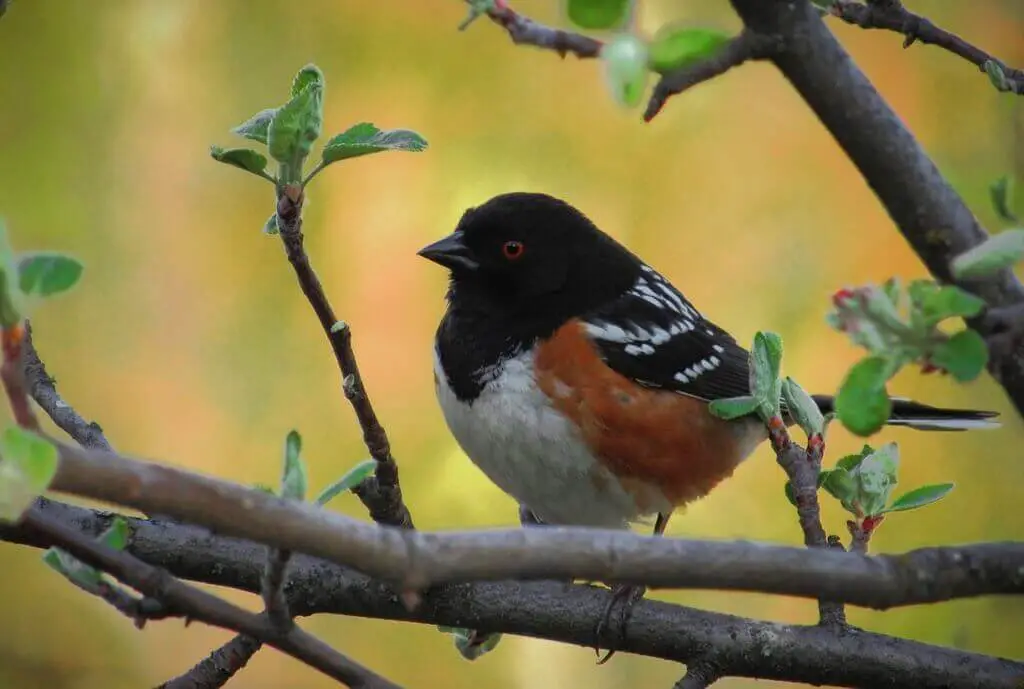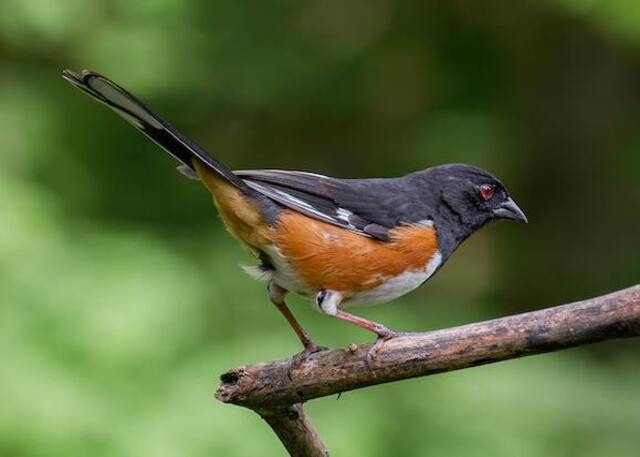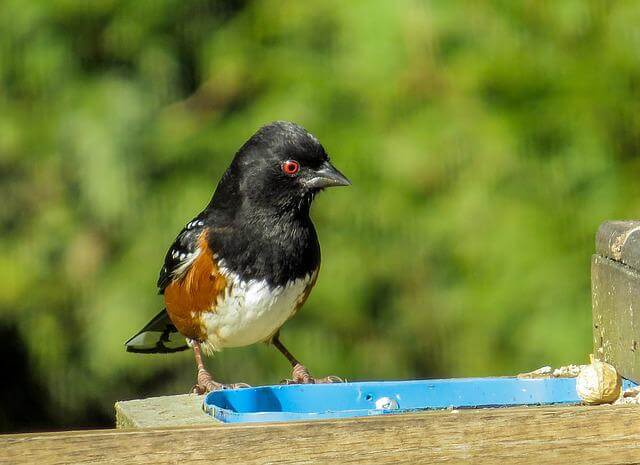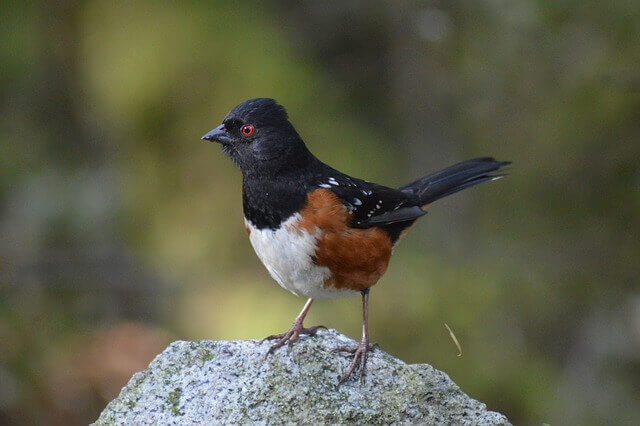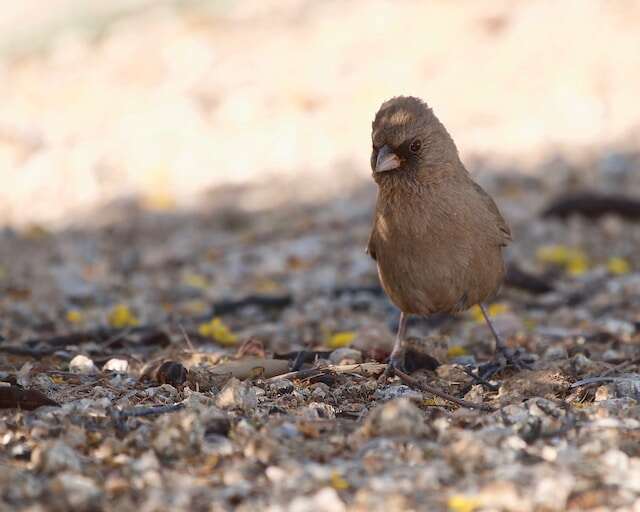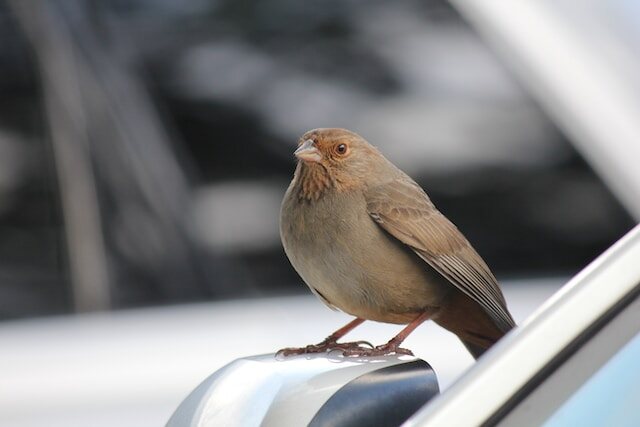Want to know how to attract towhee to your backyard? These delightful birds can infuse your outdoor space with vibrancy, and in this article, we’ll provide you with comprehensive guidance on making your yard a true towhee-friendly sanctuary.
Table of Contents
- 1 Key Takeaways
- 2 Towhee species and the regions they occur:
- 3 How to Attract Towhee to your Backyard
- 4 Understanding Towhees and Their Habits
- 5 Creating a Bird-Friendly Backyard
- 6 Towhee-Friendly Landscaping
- 7 Providing Food for Towhees
- 8 Providing Water and Bathing Areas
- 9 Creating Nesting Opportunities
- 10 Maintenance and Safety Considerations
- 11 Creating a Bird-Friendly Backyard
- 12 Conclusion
- 13 FAQs: How to Attract Towhee to your Backyard
- 14 Author
Key Takeaways
- Attracting towhees to your backyard can bring joy and life into your outdoor space.
- Certain backyard features can make your space more attractive to towhees, such as food sources, water, shelter, and nesting areas.
- Creating a natural-looking habitat with the right plants and landscaping techniques can cater to towhees’ preferences.
- Maintaining a safe environment for towhees and other backyard birds is important, including avoiding pesticides and minimizing hazards.
Towhee species and the regions they occur:
- California Towhee (Native to Western Oregon & California)
- Spotted Towhee (Occurs year-round in Oregon, California, Washington, Utah, Arizona, Nevada and British Columbia).
- Eastern Towhee (Occurs throughout Southeast Canada and Eastern United States).
- Abert’s Towhee ( Native to Colorado, Arizona, California, Nevada, Utah, New Mexico)
- Green-tailed Towhee (Occurs in West and Southwestern United States as well as Mexico)
- Collared & White-throated Towhees (Endemic to Mexico)
- Rufous-sided Towhee (Occurs in the United States and Canada)
- Bermuda Towhee (Endemic to Bermuda)
How to Attract Towhee to your Backyard
To attract towhees to your backyard, provide a bird-friendly habitat with brushy, shrubby, or overgrown borders. Consider placing a platform tray or traditional tube style feeder with black oil sunflower seeds or suet. You can also sprinkle some seed on the ground and add native plants to your garden.
Understanding Towhees and Their Habits
If you want to attract birds to your backyard, creating a towhee habitat is a great place to start. Towhees are a type of sparrow that are common in North America and can bring color and song to your outdoor space.
Towhees are known for their distinctive physical characteristics, including their rust-colored sides, black hoods, and white bellies. They have a unique foraging habit, scratching through leaf litter with both feet to uncover insects and seeds. They prefer dense undergrowth and shrubs for nesting and require a water source nearby.
Physical Characteristics
Towhees are medium-sized sparrows, with males being slightly larger than females. Adult towhees have a rust-colored back and sides and a black hood that extends to their upper chest. They also have a white belly and a long tail with white tips. Juvenile towhees have a more muted coloration and may not have a fully black hood.
Habitat and Behavior
Towhees are ground-nesting birds that prefer to live in areas with dense undergrowth, shrubs, and trees. They can be found in a variety of habitats, including woodlands, brushy areas, and suburban neighborhoods. Towhees are mostly ground-dwelling birds and will scratch through leaf litter with both feet to uncover insects and seeds. They also enjoy taking dust baths to remove parasites from their feathers.
Creating a Towhee Habitat
If you want to attract towhees to your backyard, it’s important to create a suitable habitat for them. Here are some tips:
- Plant native shrubs and trees, such as oak, hickory, and dogwood, to provide cover and nesting opportunities.
- Leave areas of your yard unmanicured to provide patches of dense undergrowth, where towhees can forage and nest.
- Provide a source of water, such as a bird bath or shallow pool, that is cleaned and refreshed regularly.
- Avoid using pesticides or herbicides in your yard, which can harm birds and their food sources.
By creating a towhee-friendly environment, you can encourage these beautiful birds to visit and nest in your backyard.
Creating a Bird-Friendly Backyard
One of the best ways to attract towhees to your backyard is to create a bird-friendly environment. A backyard that offers essential resources such as food, water, and shelter is not only attractive to towhees, but to a variety of birds. By providing a diverse habitat, you can attract a wider range of species and create an ecosystem that benefits both the birds and your outdoor space.
Bird Attracting Techniques
If you want to attract wildlife to your backyard, there are several techniques you can use to create a welcoming environment for birds. Here are a few tips to get you started:
- Plant a variety of native plants, shrubs, and trees to create a diverse habitat that attracts all types of birds, including towhees.
- Offer a variety of bird food, such as seeds and fruits, to attract different bird species.
- Provide clean and fresh water sources, such as bird baths, for birds to drink and bathe in.
- Hang bird feeders and nesting boxes to invite birds to your backyard and give them a place to rest and roost.
- Minimize the use of pesticides and chemicals in your yard that may be harmful to birds.
The Importance of Food, Water, Shelter, and Nesting Areas
To create a bird-friendly backyard, it’s essential to provide food, water, shelter, and nesting areas for birds. Here’s why:
- Food: Providing a variety of bird food is essential to attracting birds to your backyard. Birds have different dietary preferences, so offering different types of bird food will attract a diverse range of bird species, including towhees. Suet, sunflower seeds, and mealworms are some popular options.
- Water: Birds need water to drink and bathe in, so providing a clean and fresh water source is important. A bird bath or shallow pool is a great way to offer water for birds, and it can be a beautiful addition to your yard.
- Shelter: Providing shelter is crucial to attracting birds to your backyard. They need a place to rest and roost, especially during harsh weather conditions. Trees, shrubs, and dense vegetation are ideal for providing shelter for birds.
- Nesting Areas: To attract birds to your backyard, you need to give them a place to nest. Nesting boxes are a great way to provide a safe and secure space for birds to lay their eggs and raise their young. Shrubs and dense vegetation are also great options for nesting sites.
By creating a bird-friendly backyard, you’ll not only attract towhees, but a variety of bird species that will enhance the beauty of your outdoor space. With a little effort and attention to detail, you can create a thriving ecosystem that benefits both the birds and your outdoor space.
Towhee-Friendly Landscaping
When it comes to attracting native birds to your garden, creating a bird-friendly backyard is key. Towhees, in particular, have specific preferences when it comes to their habitat and landscaping. Here are some tips for creating a towhee-friendly outdoor space.
Plant Native Shrubs and Trees
Towhees prefer a dense and natural-looking habitat, so planting native shrubs and trees is essential. Some good options include serviceberry, dogwood, elderberry, and spicebush. These plants provide food and shelter for towhees, and they also attract a variety of other birds and insects.
| Shrub Name | Shrub | Shrub | Shrub | Shrub |
|---|---|---|---|---|
| Ragweed | Mountain Ash | Black Hawthorn | Beach Strawberry | California Black Walnut |
| Blueberry | Oak | Sumac | Thistle | Amaranth |
| Currant | Gooseberry | Elderberry | Flowering Crabapple | Black Huckleberry |
| Raspberry | Chickweed | Honeysuckle | Barberry | Cherry |
| Blackberry | Snowberry |
Provide Ground Cover
Towhees spend a lot of time on the ground, so it’s important to provide suitable ground cover in your backyard. Leaf litter, fallen branches, and rocks can all create a natural-looking environment for towhees and other native birds. Consider mulching your garden beds with organic materials like wood chips or bark to create a diverse and welcoming habitat.
Avoid Chemical Pesticides
Towhees are sensitive to chemical pesticides and herbicides, so it’s important to avoid using these products in your backyard. Instead, opt for natural pest control methods like companion planting or handpicking pests. This will help create a healthy and safe environment for towhees and other backyard wildlife.
Provide Nesting Opportunities
Towhees build their nests on the ground, often in dense vegetation or shrubs. Consider leaving certain areas of your backyard untouched to provide natural nesting materials. You can also install birdhouses or nest boxes specifically designed for towhees to provide additional nesting opportunities.
By following these tips for towhee-friendly landscaping, you can create a diverse and welcoming backyard habitat for these beautiful native birds. Not only will you enjoy watching them flutter and hop around your garden, but you’ll also be providing a safe and healthy environment for them to thrive.
Providing Food for Towhees
Towhees are primarily seed-eaters and insectivores, but they also enjoy fruit and berries. To attract towhees to your backyard, it’s essential to provide a variety of food options.
Here are some tips on how to provide suitable food sources for towhees:
- Offer a variety of seeds such as sunflower seeds, millet, and nyjer. Place them in a feeder or scatter them on the ground.
- Provide fruits and berries such as chopped apples, blueberries, and grapes. Place them in a shallow dish or on a platform feeder.
- Include insects and mealworms in your offerings. These can be purchased at pet stores or online.
- Avoid feeding birds with bread, crackers, or other processed foods as they can be harmful to their health.
An effective way to attract towhees to your backyard is by using either a platform tray or a traditional tube-style feeder. In my experience, the traditional style feeder is preferable due to its lower maintenance requirements and reduced risk of attracting unwanted guests.
One product I highly recommend is the Squirrel-proof Bird Feeder, which pairs exceptionally well with Black-oil Sunflower Seed. I’ve found the best prices for these products on Amazon.
Since towhees enjoy ground feeding, it’s essential to position the feeder no more than 5 feet above the ground and provide some shelter to offer protection from potential predators.
To entice towhees, fill your feeders with a blend of white proso millet and sunflower seeds. If you opt for a tray feeder, ensure it has proper drainage to prevent spoilage.
Alternatively, you can enhance your backyard by scattering white proso millet directly on your lawn, providing an additional foraging opportunity for these delightful birds.
By offering a variety of food sources, you’ll not only attract towhees but other backyard birds as well.
Providing Water and Bathing Areas
Water is essential for attracting native birds to your garden, and towhees are no exception. A clean and fresh water source will not only attract towhees but also provide them with a place to bathe, which is essential for their health and hygiene.
Creating a bird bath like this one on Amazon or a shallow pool is an excellent way to provide water for towhees and other birds. Ensure that the water is at a suitable depth and frequently replenished to prevent contamination and stagnation. You can also add features like fountains or misters to enhance the attraction.
It is essential to keep the water source clean and free from debris and harmful chemicals. Regularly empty and scrub the vessel, refilling it with fresh water. Place the water source in a shaded area to keep the temperature cool and prevent algae growth.
In addition to a dedicated water source, you can also incorporate plants that can provide moisture for towhees. Plants like succulents and berry bushes produce dew and nectar that birds can drink. You can also install a drip irrigation system to water your plants and create a wet area in your garden.
Creating Nesting Opportunities
One of the most crucial aspects of attracting towhees to your backyard is providing suitable nesting opportunities. Towhees prefer nesting in dense shrubs and vegetation, and it’s essential to leave certain areas of your backyard undisturbed to provide natural nesting materials.
Consider planting native shrubs and trees to provide a diverse and natural-looking habitat. Shrubs such as hawthorns, serviceberries, and elderberries are popular among towhees.
You can also install a nest box specifically designed for towhees. Make sure the box is placed in an area with dense vegetation, and keep it at a height of 3 to 6 feet above the ground.
Leaving dead leaves and fallen branches in certain areas can also provide natural nesting materials for towhees and other birds.
Overall, creating suitable nesting opportunities is crucial in attracting and maintaining a healthy towhee population in your backyard. By providing a diverse and natural habitat, you can encourage these beautiful birds to make their home in your outdoor space.
Maintenance and Safety Considerations
Creating a towhee-friendly backyard requires regular maintenance and safety considerations to ensure a healthy environment for these birds and other backyard wildlife. Here are some tips:
Cleanliness is Key
Regular cleaning of bird feeders, bird baths, and nesting areas is essential to prevent the spread of disease among birds. Use mild soap and water, or a 10% bleach solution to clean. Rinse thoroughly and dry before refilling.
Avoid Pesticides
Pesticides and herbicides can be harmful to birds and may reduce their food sources. Use natural pest control methods instead, such as companion planting, insect-repelling plants, and physical barriers.
Minimize Hazards
Window collisions are a common cause of bird mortality. Consider placing decals or other bird-safe measures on your windows to prevent collisions. Avoid using glue traps and other potential hazards that can injure or kill birds.
Provide a Safe Haven
Avoid placing bird feeders and bird baths in areas where predators, such as cats and hawks, can easily access them. Provide dense vegetation and cover for birds to hide and take shelter in. Consider placing nest boxes near natural cover, away from potential predators.
Creating a Bird-Friendly Backyard
Attracting towhees to your backyard is not only beneficial for these beautiful birds, but it also adds to the charm of your outdoor space. But how can you create a backyard that is welcoming to towhees and other bird species? Here are some tips for making your backyard a bird-friendly haven.
Provide Food Sources
Towhees love to feed on a variety of seeds, fruits, and insects. To attract towhees to your backyard, offer a selection of foods that appeal to them. Black oil sunflower seeds, millet, and safflower seeds are all good options. Fruits like apples, berries, and grapes are also popular with towhees. You can also attract insects by planting flowers and herbs such as marigolds, dill, and fennel.
Offer Water Sources
Water is essential for all birds, including towhees. A bird bath or a shallow pool can be a great addition to your backyard. Be sure to regularly change the water to keep it fresh and clean. If possible, add a dripper or a fountain to create a continuous flow of water, which will be even more attractive to birds.
Provide Shelter and Nesting Areas
Towhees prefer dense vegetation and plenty of cover. Provide shelter by planting shrubs and trees that will offer protection from predators and harsh weather conditions. Creating nesting areas is also important. Towhees prefer to nest on the ground, so leave some fallen leaves and twigs in certain areas of your yard. You can also provide nest boxes for towhees to raise their young.
Avoid Pesticides and Hazardous Materials
To maintain a healthy environment for your backyard birds, avoid using pesticides and other hazardous materials. These substances can be harmful to birds and can also contaminate their food and water sources. Opt for natural pest control methods and avoid using chemicals and toxins in your yard.
Conclusion
Creating a bird-friendly backyard requires some effort, but the payoff is well worth it. By providing food, water, shelter, and nesting areas, you can attract towhees and other bird species to your outdoor space. Remember to maintain a safe and healthy environment by avoiding pesticides and other hazards.
With a little time and attention, you can enjoy the beauty of towhees in your backyard. Follow these tips for creating a backyard sanctuary for birds and enjoy the beauty of nature right in your own backyard.
FAQs: How to Attract Towhee to your Backyard
How do I attract towhees to my backyard?
To attract towhees to your backyard, create a bird-friendly environment by providing food, water, shelter, and nesting areas. Plant native plants and shrubs that towhees prefer and offer a variety of food options, such as seeds, fruits, and insects.
What should I consider when landscaping for towhees?
When landscaping for towhees, focus on creating a diverse and natural-looking habitat. Use plants, shrubs, and trees that towhees prefer, and aim for a mix of vegetation heights and densities to provide cover and foraging opportunities.
What should I feed towhees?
Towhees have a diverse diet that includes seeds, fruits, and insects. Offer a variety of food options, such as sunflower seeds, berries, and mealworms, in feeders or scattered throughout your backyard to attract towhees.
How can I provide water for towhees?
Towhees need access to clean and fresh water. Create bird baths, water features, or shallow pools in your backyard that towhees can use for drinking and bathing. Ensure that the water is regularly cleaned and refilled.
How can I create nesting opportunities for towhees?
Towhees prefer nesting in shrubs, dense vegetation, or nest boxes. Plant suitable shrubs and offer areas with dense vegetation for towhees to build their nests. You can also provide nest boxes designed specifically for towhees.
How can I maintain a safe environment for towhees?
Maintain a safe environment for towhees by regularly cleaning feeders and water sources to prevent the spread of disease. Avoid using pesticides in your backyard and take measures to minimize hazards like window collisions or predation.

